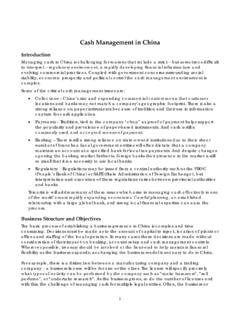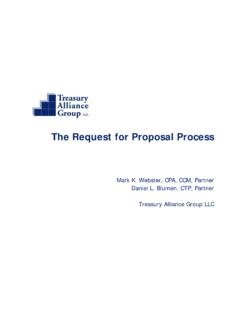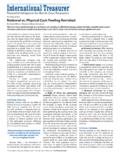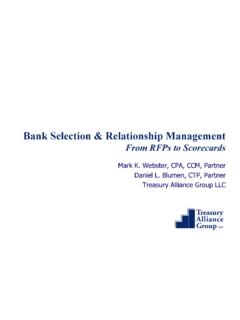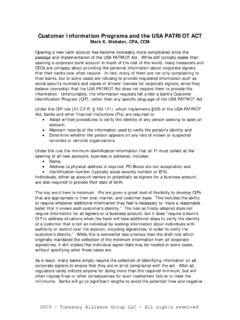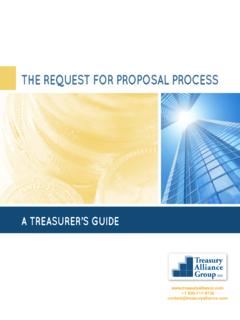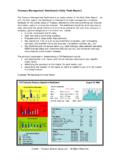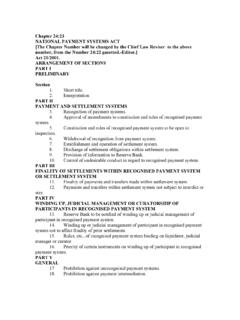Transcription of Fundamentals of Global Payment Systems and …
1 Fundamentals of Global Payment Systems and Practices 1 Payment Systems 2 Payment Channels 51. Paper-Based payments 62. High-Value Transfers 73. Batch EFT Systems 94. Card Based payments 11 Payment Processing and Controls 13 Settlement 16 Alternative Payment Systems 18 Summary 22 2018 Treasury Alliance Group llc. All Rights to the 2018 Edition of Fundamentals of Global Payment Systems and are the lifeblood of any business - without the ability to pay and receive money there can be no be no business. They are also a big business with industry revenues measured in the trillions of dollars and participants frequently entering and exiting the market. Creative payments strategies are an opportunity to reach new customers through mobile and other channels while also achieving cost reductions. payments also represent a big source of risk from Systems or counterparty failures as well as cybercrime and conventional Alliance Group is pleased to present this updated version of our Fundamentals of Payment Systems first issued in 2014.
2 The 2018 edition has updated coverage on many elements of payments including fraud and alternative Payment Systems . We hope that you find this guide useful in learning more about Payment Systems around the world and some of the issues that surround pay-ments Alliance Group is here to help and provides consulting assistance in the areas of payments strategy, product development, security and risk reviews, network design and optimization, vendor selection and opera-tional best practices and internal controls. Contact us at or by phone at +1 630-717-9728. 2018 Treasury Alliance Group llc. All Rights oF Global Payment Systems and PracticesIntroductionPayments are the financial instruments used globally to transfer value in the form of money. This makes them an essential part a company s financial operations, and a complex part given the many different Payment Systems and currencies used around the world.
3 Further challenges come from the continual introduction of newer Payment offerings such as PayPal, Bitcoin and various mobile Payment options. The result is that there are now well over 750 Payment Systems throughout the world Systems that are constantly chang-ing due to new technology or government purpose of this paper is to provide corporate treasury professionals with the working knowledge necessary to make informed decisions about Payment practices for their organization. It is divided into six sections:I. Payment Systems describes the essential elements of a Payment system and the Payment Channels covers the four basic payments types; paper-based, high-value real time Systems (wires), batch EFT Systems (ACH) and Payment Processing and Controls looks at payments from the corporate perspective dealing with topics such as making payments and process-ing Settlement describes how financial institutions involved in payments exchange value between each Alternative payments deals with less conventional, often non-bank, payments Systems , such as Hawala, digital wallets, mobile payments and Conclusion summarizes the topic and provides directions to additional resources.
4 2018 Treasury Alliance Group llc. All Rights oF Global Payment Systems and PracticesPayment SystemsA Payment system is a set of processes and technologies that transfer mon-etary value from one entity or person to another. payments are typically made in exchange for the provision of goods, services or to satisfy a legal obligation. They can be made in a variety of currencies using several methods such as cash, checks, electronic payments and cards. The essence of a Payment system is that it uses cash-substitutes, such as checks or electronic messages, to create the debits and credits that transfer value. The value that is being transferred is typically stored in depository accounts at banks or other types of financial institutions. The banks, in turn, are connected to a set of Payment Systems that they use to process payments on behalf of their customers or depositors.
5 Most US banks are members of a number of different Payment Systems such as Fedwire (US Federal Reserve Bank network), Point of Sale (POS) and card networks such as NYCE (New York Cash Exchange, a subsidiary of FIS) and CHIPS (Clearing House Interbank Payment Systems ). Other countries have similar Systems such as CNAPS (China), BOJNET (Japan) and SPEI (Mexico). Banks operating in multiple countries connect to Payment Systems in each of the countries where they operate either directly or through a corre-spondent bank. Significantly for the settlement process and for the discussion of less conventional Payment Systems , banks in many countries typically maintain accounts with a country s central bank and participate in the central bank s pay-ment Systems . In the Eurozone, the authorities have taken it a step further by creating SEPA, the Single European payments Area, under the authority of the European Central Bank (ECB).
6 SEPA was created to provide standardized pay-ments processing and fees among all the various countries within the Eurozone. In the simplest case involving the traditional banking system , payments involve four participants: |The payer: Makes the Payment and has its bank account debited for the value of the transaction. |The payer s financial institution: Processes the transaction on the payer s behalf. |The payee s financial institution: Processes the transaction on behalf of the payee and generally holds the value in an account. |The payee: Receives value of the Payment by credit to its 2018 Treasury Alliance Group llc. All Rights oF Global Payment Systems and PracticesThis is illustrated in the four corners Payment model diagram shown below. In the simple case illustrated here the two banks may choose to transfer Payment instructions and funds directly with each other.
7 It is also possible for the banks to use various intermediaries to help facilitate the transaction. The diagram refers to these intermediaries as network .In the real world the network includes central banks such as the US Federal Reserve (FRB), European Central Bank (ECB) and The Bank of Japan (BOJ) along with clearinghouses such as CHIPS. There are also information trans-mission mechanisms such as the Society for Worldwide Interbank Financial Telecommunications (SWIFT) and Payment Systems such as Fedwire and BOJNet which also include information transmission Systems . Entities such as payroll processors, check printers, Systems providers and card Systems such as Visa and MasterCard that are outside of the four corners model also partici-pate in the Payment process. Non-traditional Payment Systems such as Bitcoin bypass the banking system almost entirely by fulfilling the roles of financial institution, currency and network themselves.
8 2018 Treasury Alliance Group llc. All Rights oF Global Payment Systems and PracticesThe operation of the model is often referred to as the Payment process and it involves four basic steps: | Payment instructions are the information contained in a wire transfer or check. These instructions are from the payer and tell the paying bank to transfer value to the beneficiary through the network and receiving bank. | Payment generation is when the instructions are entered into the system printed on a check or transmitted via ACH or wire. |Clearing is the process where the banks use the Payment information to transfer money between themselves on behalf of the payer and the beneficiary (payee). |Settlement is the final step in the basic process and occurs when the beneficiary s (payee s) bank account is credited and the payer s bank account is debited.
9 Final settlement occurs when the banks irrevocably pass value among themselves, a distinction that has important trea-sury actual Payment process will depend on the type of Payment instrument that the payer and payee choose to use or have chosen for them by their financial institutions. 2018 Treasury Alliance Group llc. All Rights oF Global Payment Systems and PracticesPayment ChannelsPayments originators and their processers can use different channels to make a Payment and each has different operating characteristics, rules and settle-ment mechanisms. Broadly speaking, all Payment Systems can be placed into one of the following five Payment channels: |Paper-based Systems such as checks or drafts. payments are initiated when one party writes an instruction on paper to pay another. These Systems are one of the oldest forms of non-cash Payment system .
10 Checks are a common paper-based channel and while in decline are still widely used in the United States and a few other countries. |RTGS (Real Time Gross Settlement) and other high-value payments ; called wire transfers by most people. Wires came into being in the late 1800s with the invention of the telegraph but did not become widely used until the early 1900s. |Low Value Batch Systems or Automated Clearing House (ACH) batch payments were introduced in the early 1970s and were designed to replace checks with electronic payments . Unlike wires, which are processed individually, ACH payments are processed in batches and were originally intended for small payments under $100,000 such as payroll and consumer transactions. |Cards are a Payment channel that includes credit, debit and stored value cards. They are a heavily used and fast growing segment of the methods for making and receiving payments .
